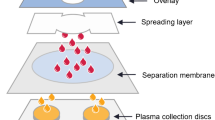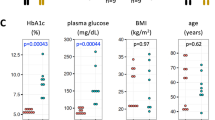Abstract
Introduction
Mass spectrometry and computational biology have advanced significantly in the past ten years, bringing the field of metabolomics a step closer to personalized medicine applications. Despite these analytical advancements, collection of blood samples for routine clinical analysis is still performed through traditional blood draws.
Objective
TAP capillary blood collection has been recently introduced for the rapid, painless draw of small volumes of blood (~ 100 μL), though little is known about the comparability of metabolic phenotypes of blood drawn via traditional venipuncture and TAP devices.
Methods
UHPLC-MS-targeted metabolomics analyses were performed on blood drawn traditionally or through TAP devices from 5 healthy volunteers. Absolute quantitation of 45 clinically-relevant metabolites was calculated against stable heavy isotope-labeled internal standards.
Results
Ranges for 39 out of 45 quantified metabolites overlapped between drawing methods. Pyruvate and succinate were over threefold higher in the TAP samples than in traditional blood draws. No significant changes were observed for other carboxylates, glucose or lactate. TAP samples were characterized by increases in reduced glutathione and decreases in urate and cystine, markers of oxidation of purines and cysteine—overall suggesting decreased oxidation during draws. The absolute levels of bile acids and acyl-carnitines, as well as almost all amino acids, perfectly correlated among groups (Spearman r ≥ 0.95).
Conclusion
Though further more extensive studies will be mandatory, this pilot suggests that TAP-derived blood may be a logistically-friendly source of blood for large scale metabolomics studies—especially those addressing amino acids, glycemia and lactatemia as well as bile acids, acyl-carnitine levels.






Similar content being viewed by others
References
Avignon, A., Radauceanu, A., & Monnier, L. (1997). Nonfasting plasma glucose is a better marker of diabetic control than fasting plasma glucose in type 2 diabetes. Diabetes Care, 20(12), 1822–1826.
Beger, R. D., Dunn, W., Schmidt, M. A., Gross, S. S., Kirwan, J. A., Cascante, M., et al. (2016). Metabolomics enables precision medicine: “A white paper, community perspective”. Metabolomics, 12(9), 149. https://doi.org/10.1007/s11306-016-1094-6.
Blicharz, T. M., Gong, P., Bunner, B. M., Chu, L. L., Leonard, K. M., Wakefield, J. A., et al. (2018). Microneedle-based device for the one-step painless collection of capillary blood samples. Nature Biomedical Engineering, 2(3), 151–157. https://doi.org/10.1038/s41551-018-0194-1.
Chouchani, E. T., Pell, V. R., Gaude, E., Aksentijević, D., Sundier, S. Y., Robb, E. L., et al. (2014). Ischaemic accumulation of succinate controls reperfusion injury through mitochondrial ROS. Nature, 515(7527), 431–435. https://doi.org/10.1038/nature13909.
Crutchfield, C. A., Thomas, S. N., Sokoll, L. J., & Chan, D. W. (2016). Advances in mass spectrometry-based clinical biomarker discovery. Clinical Proteomics. https://doi.org/10.1186/s12014-015-9102-9.
D’Alessandro, A., Giardina, B., Gevi, F., Timperio, A. M., & Zolla, L. (2012). Clinical metabolomics: The next stage of clinical biochemistry. Blood Transfusion = Trasfusione Del Sangue, 10(Suppl 2), s19–24. https://doi.org/10.2450/2012.005S.
D’Alessandro, A., Moore, H. B., Moore, E. E., Wither, M., Nemkov, T., Gonzalez, E., et al. (2015). Early hemorrhage triggers metabolic responses that build up during prolonged shock. American Journal of Physiology. Regulatory, Integrative and Comparative Physiology, 308(12), R1034–R1044. https://doi.org/10.1152/ajpregu.00030.2015.
D’Alessandro, A., Nemkov, T., Yoshida, T., Bordbar, A., Palsson, B. O., & Hansen, K. C. (2017). Citrate metabolism in red blood cells stored in additive solution-3. Transfusion, 57(2), 325–336. https://doi.org/10.1111/trf.13892.
DʼAlessandro, A., Moore, H. B., Moore, E. E., Reisz, J. A., Wither, M. J., Ghasasbyan, A., et al. (2017). Plasma succinate is a predictor of mortality in critically injured patients. The Journal of Trauma and Acute Care Surgery, 83(3), 491–495. https://doi.org/10.1097/TA.0000000000001565.
Dettmer, K., Aronov, P. A., & Hammock, B. D. (2007). Mass spectrometry-based metabolomics. Mass Spectrometry Reviews, 26(1), 51–78. https://doi.org/10.1002/mas.20108.
Fuhrer, T., Heer, D., Begemann, B., & Zamboni, N. (2011). High-throughput, accurate mass metabolome profiling of cellular extracts by flow injection-time-of-flight mass spectrometry. Analytical Chemistry, 83(18), 7074–7080. https://doi.org/10.1021/ac201267k.
Gehrke, S., Reisz, J. A., Nemkov, T., Hansen, K. C., & D’Alessandro, A. (2017). Characterization of rapid extraction protocols for high-throughput metabolomics. Rapid Communications in Mass Spectrometry: RCM, 31(17), 1445–1452. https://doi.org/10.1002/rcm.7916.
Herrero, M., Simó, C., García-Cañas, V., Ibáñez, E., & Cifuentes, A. (2012). Foodomics: MS-based strategies in modern food science and nutrition. Mass Spectrometry Reviews, 31(1), 49–69. https://doi.org/10.1002/mas.20335.
Jobard, E., Trédan, O., Postoly, D., André, F., Martin, A.-L., Elena-Herrmann, B., & Boyault, S. (2016). A systematic evaluation of blood serum and plasma pre-analytics for metabolomics cohort studies. International Journal of Molecular Sciences. https://doi.org/10.3390/ijms17122035.
Kok, M. G. M., & Fillet, M. (2018). Volumetric absorptive microsampling: Current advances and applications. Journal of Pharmaceutical and Biomedical Analysis, 147, 288–296. https://doi.org/10.1016/j.jpba.2017.07.029.
Krishna, U., Joshi, S. P., & Modh, M. (2009). An evaluation of serial blood lactate measurement as an early predictor of shock and its outcome in patients of trauma or sepsis. Indian Journal of Critical Care Medicine, 13(2), 66–73. https://doi.org/10.4103/0972-5229.56051.
Kurbegov, A. C., Setchell, K. D. R., Haas, J. E., Mierau, G. W., Narkewicz, M., Bancroft, J. D., et al. (2003). Biliary diversion for progressive familial intrahepatic cholestasis: Improved liver morphology and bile acid profile. Gastroenterology, 125(4), 1227–1234.
Lana, A., Longo, V., Dalmasso, A., D’Alessandro, A., Bottero, M. T., & Zolla, L. (2015). Omics integrating physical techniques: Aged Piedmontese meat analysis. Food Chemistry, 172, 731–741. https://doi.org/10.1016/j.foodchem.2014.09.146.
Lewis, M. R., Pearce, J. T. M., Spagou, K., Green, M., Dona, A. C., Yuen, A. H. Y., et al. (2016). Development and application of ultra-performance liquid chromatography-TOF MS for precision large scale urinary metabolic phenotyping. Analytical Chemistry, 88(18), 9004–9013. https://doi.org/10.1021/acs.analchem.6b01481.
López-Bascón, M. A., Priego-Capote, F., Peralbo-Molina, A., Calderón-Santiago, M., & Luque de Castro, M. D. (2016). Influence of the collection tube on metabolomic changes in serum and plasma. Talanta, 150, 681–689. https://doi.org/10.1016/j.talanta.2015.12.079.
Lusczek, E. R., Muratore, S. L., Dubick, M. A., & Beilman, G. J. (2017). Assessment of key plasma metabolites in combat casualties. Journal of Trauma and Acute Care Surgery, 82(2), 309. https://doi.org/10.1097/TA.0000000000001277.
Maddocks, O. D. K., Labuschagne, C. F., Adams, P. D., & Vousden, K. H. (2016). Serine metabolism supports the methionine cycle and DNA/RNA methylation through De Novo ATP synthesis in cancer cells. Molecular Cell, 61(2), 210–221. https://doi.org/10.1016/j.molcel.2015.12.014.
McCurdy, C. E., Schenk, S., Hetrick, B., Houck, J., Drew, B. G., Kaye, S., et al. (2016). Maternal obesity reduces oxidative capacity in fetal skeletal muscle of Japanese macaques. JCI Insight, 1(16), e86612. https://doi.org/10.1172/jci.insight.86612.
Mondanelli, G., Bianchi, R., Pallotta, M. T., Orabona, C., Albini, E., Iacono, A., et al. (2017). A relay pathway between arginine and tryptophan metabolism confers immunosuppressive properties on dendritic cells. Immunity, 46(2), 233–244. https://doi.org/10.1016/j.immuni.2017.01.005.
Nemkov, T., D’Alessandro, A., & Hansen, K. C. (2015). Three-minute method for amino acid analysis by UHPLC and high-resolution quadrupole orbitrap mass spectrometry. Amino Acids, 47(11), 2345–2357. https://doi.org/10.1007/s00726-015-2019-9.
Nemkov, T., Hansen, K. C., & D’Alessandro, A. (2017). A three-minute method for high-throughput quantitative metabolomics and quantitative tracing experiments of central carbon and nitrogen pathways. Rapid Communications in Mass Spectrometry: RCM, 31(8), 663–673. https://doi.org/10.1002/rcm.7834.
Palau-Rodriguez, M., Tulipani, S., Isabel Queipo-Ortuño, M., Urpi-Sarda, M., Tinahones, M., Tinahones, F. J., & Andres-Lacueva, C. (2015). Metabolomic insights into the intricate gut microbial–host interaction in the development of obesity and type 2 diabetes. Frontiers in Microbiology. https://doi.org/10.3389/fmicb.2015.01151.
Reisz, J. A., Slaughter, A. L., Culp-Hill, R., Moore, E. E., Silliman, C. C., Fragoso, M., et al. (2017). Red blood cells in hemorrhagic shock: A critical role for glutaminolysis in fueling alanine transamination in rats. Blood Advances, 1(17), 1296–1305. https://doi.org/10.1182/bloodadvances.2017007187.
Townsend, M. K., Bao, Y., Poole, E. M., Bertrand, K. A., Kraft, P., Wolpin, B. M., et al. (2016). Impact of pre-analytic blood sample collection factors on metabolomics. Cancer Epidemiology, Biomarkers & Prevention, 25(5), 823–829. https://doi.org/10.1158/1055-9965.EPI-15-1206.
Uppal, K., Walker, D. I., Liu, K., Li, S., Go, Y.-M., & Jones, D. P. (2016). Computational metabolomics: A framework for the million metabolome. Chemical Research in Toxicology, 29(12), 1956–1975. https://doi.org/10.1021/acs.chemrestox.6b00179.
Wang, Q., Sun, T., Cao, Y., Gao, P., Dong, J., Fang, Y., et al. (2016). A dried blood spot mass spectrometry metabolomic approach for rapid breast cancer detection. OncoTargets and Therapy, 9, 1389–1398. https://doi.org/10.2147/OTT.S95862.
Wilson, I. (2011). Global metabolic profiling (metabonomics/metabolomics) using dried blood spots: advantages and pitfalls. Bioanalysis, 3(20), 2255–2257. https://doi.org/10.4155/bio.11.221.
Wishart, D. S., Feunang, Y. D., Marcu, A., Guo, A. C., Liang, K., Vázquez-Fresno, R., et al. (2018). HMDB 4.0: The human metabolome database for 2018. Nucleic Acids Research, 46(D1), D608–D617. https://doi.org/10.1093/nar/gkx1089.
Yin, P., Lehmann, R., & Xu, G. (2015). Effects of pre-analytical processes on blood samples used in metabolomics studies. Analytical and Bioanalytical Chemistry, 407(17), 4879–4892. https://doi.org/10.1007/s00216-015-8565-x.
Zukunft, S., Sorgenfrei, M., Prehn, C., Möller, G., & Adamski, J. (2013). Targeted metabolomics of dried blood spot extracts. Chromatographia, 76(19–20), 1295–1305. https://doi.org/10.1007/s10337-013-2429-3.
Acknowledgements
Research reported in this publication was supported in part by funds from the Boettcher Webb-Waring Biomedical Research Award—Early Career grant (ADA) and the Shared Instrument grant by the National Institute of Health (S10OD021641). We would like to thank Seventh Sense for kindly and gratuitously donatng prototype TAP devices for the sake of this pilot study.
Author information
Authors and Affiliations
Corresponding author
Ethics declarations
Conflict of interest
Though unrelated to the contents of this manuscript, ADA and TN are founders of Omix Technologies Inc and ALTIS Biosciences LLC. ADA is a consultant for New Health Sciences Inc. All the remaining authors have no conflicts of interest to disclose. No economic support was provided by Seventh Sense Biosystems, except for the kind donation of a limited number of prototypes tested in this study.
Electronic supplementary material
Below is the link to the electronic supplementary material.

Rights and permissions
About this article
Cite this article
Catala, A., Culp-Hill, R., Nemkov, T. et al. Quantitative metabolomics comparison of traditional blood draws and TAP capillary blood collection. Metabolomics 14, 100 (2018). https://doi.org/10.1007/s11306-018-1395-z
Received:
Accepted:
Published:
DOI: https://doi.org/10.1007/s11306-018-1395-z




